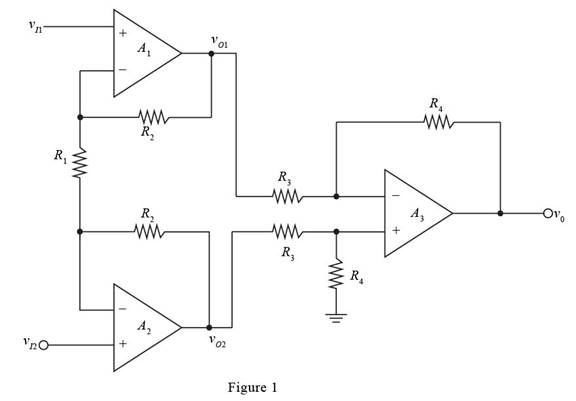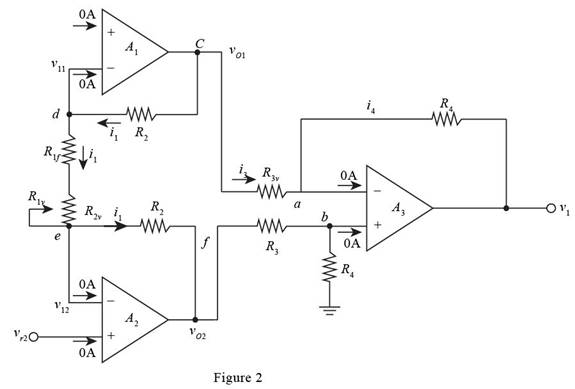
All parameters associated with the instrumentation amplifier in Figure 9.26are the same as given in Exercise Ex 9.8, except that resistor
The value of maximum common mode gain.
Answer to Problem 9.72P
The maximum value of the voltage gain is
Explanation of Solution
Calculation:
The given diagram is shown in Figure 1

Mark the voltages and current and redraw the circuit.
The required diagram is shown in Figure 2

The expression for the voltage
The expression for the current at the node
Substitute
Apply KCL at the node
Substitute
The expression for the value of the current
The expression for the voltage
Substitute
The expression for the voltage
Substitute
Substitute
The expression for the common mode voltage is given by,
The expression for the differential voltage is given by,
The expression for the voltage
The expression for the voltage
Substitute
The general expression for the output equation is given by,
From above and from equation (3), the expression for the common mode gain is evaluated as,
Substitute
From above the range of the common mode voltage gain is given by,
The maximum value of the voltage gain is given by,
Conclusion:
Therefore, themaximum value of the voltage gain is
Want to see more full solutions like this?
Chapter 9 Solutions
Microelectronics: Circuit Analysis and Design
- Question 3: Please write answers to all parts of the question in the separate dot points as shown What is the circuit called? Discuss all components including voltage sources. Which components determine the closed-loop gain of the circuit? Describe the slew-rate of the op-amp. Describe the Common-Mode-Rejection ratio of the op-amp? What is the unity gain bandwidth? Describe the gain bandwidth product (GBP). Describe the GBP relationship between the break (critical) frequency and the gain? What two methods calculate the max frequency? If one produces a higher value of maximum frequency than the other, which would you use as the maximum frequency?arrow_forwardMention three properties of an ideal operational amplifier.arrow_forwardOutline the main features of a non-inverting operational amplifierarrow_forward
- What’s a complex example of a Non-Inverting Amplifier?arrow_forwardSketch the root locus for the unity feedback systemshownin Figure P8.3 forthe followingtransfer functions:[Section: 8.4]arrow_forwardA unity-feedback system has forward transfer function (see attached). a) Sketch the root locus for this system as K varies from 0 to ∞; b) Use the Routh-Hurwitz test to determine the range of K for the system to be stable; show this value of K on the root locus plot.arrow_forward
- The transistor parameters for the circuit shown are VTN = 0.4 V, Kn =0.5 mA/V2, and λ = 0.(a) Discuss the feedback topology, show the input ant output connections (series orshunt)(b) Find the feedback factor β (find the transfer function without feedback first)arrow_forwardCompare the closed-loop voltage gain, k = Vo/Vs, for the loaded and unloaded dependent source model of the Voltage Follower with the ideal model of the Voltage to examine the impact of the load, RL on k. - Using any circuit analysis method, derive expressions for the closed-loop gain, k = Vo/Vs, for the ideal opamp Voltage Follower ,both the unloaded ,loaded Voltage Follower using the dependent source model. simplify both of the closed-loop gain expressions for the dependent source models by applying the ideal opamp parameters: A --> infinity , R_i -->infinity and R_0 --> infinity.arrow_forwardGiven in the figure is a two-stage amplifier design that employs negative feedback. Answer the following questions. Use the notation (R1 + R2 + ... + Rn) for series resistors and (R1 || R2 || ... || Rn) for parallel resistors for clarity and ease. Assume that the transistors are already biased properly in the saturation region and ro1 = ro2 → ∞. Also assume that the capacitors have infinite capacitance. 1.) Find the expression for the open loop gain Av 2.) Derive the resistance Rin which is the resistance that can be seen at the input port of the amplifierarrow_forward
- Assume for a moment that perfectly accurate resistors were available for feedback networks; that is resistor tolerance is 0%. Then any deviation from the value set by the feedback resistor ratio is caused by insufficient raw op-amp gain. What minimum raw gain would be needed to get within 1% if an intended overall gain of 10? What if the intended gain is 100 instead?arrow_forwardProvide a simple sample problem scenarios with correct solution regarding phase deviation for phase modulation (PM).arrow_forwardAn inverting op – amplifier stage is designed with an input resistance of 5 KΩ and feedback resistance of 10 KΩ. The load resistance is 100 Ω with DC gain of 5x10^4 . The output internal resistance is 500 Ω while the input impedance is infinity, assuming an input voltage of 1.5 volts, calculate the following ?a) The AC gain ?b) The output voltage ?c) The looking back resistance ?arrow_forward
 Power System Analysis and Design (MindTap Course ...Electrical EngineeringISBN:9781305632134Author:J. Duncan Glover, Thomas Overbye, Mulukutla S. SarmaPublisher:Cengage Learning
Power System Analysis and Design (MindTap Course ...Electrical EngineeringISBN:9781305632134Author:J. Duncan Glover, Thomas Overbye, Mulukutla S. SarmaPublisher:Cengage Learning
